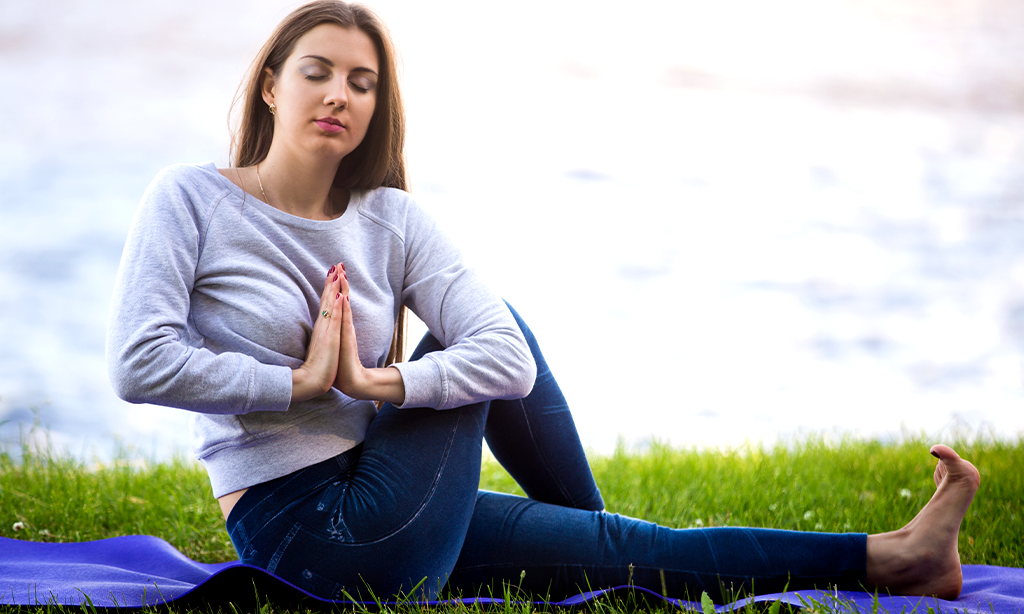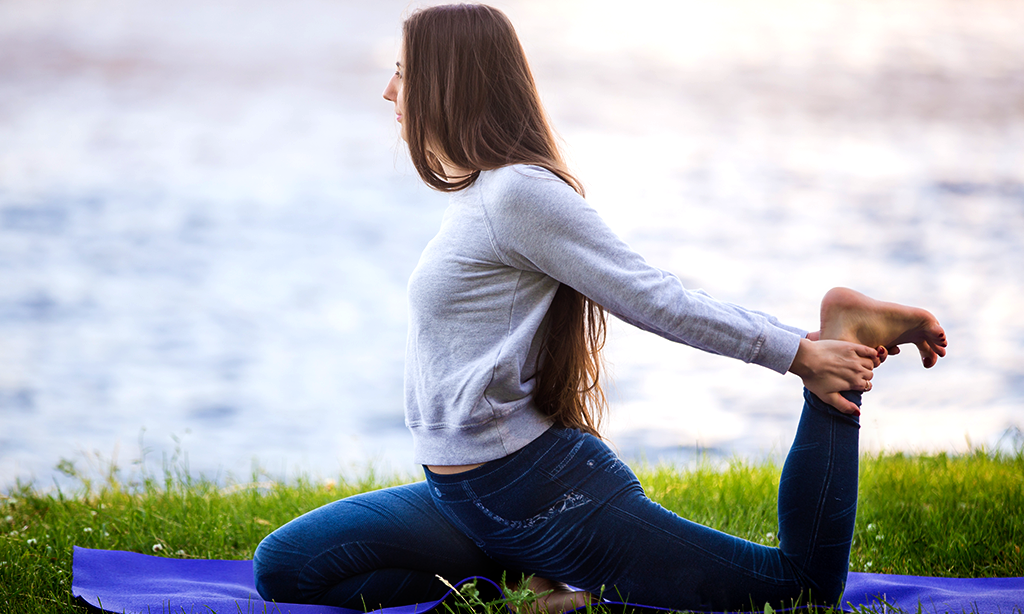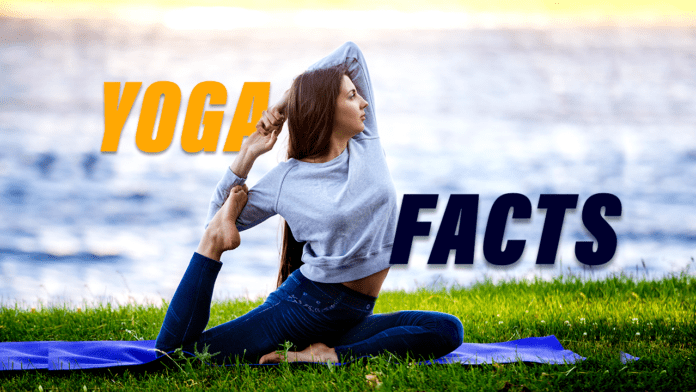In a world that moves faster than ever, finding peace and balance can be as challenging as holding a tree pose on a windy day. If you’ve been feeling out of sync or seeking ways to enhance your well-being, yoga might just be the answer you’ve been searching for.
Imagine an ancient practice that not only stretches your muscles but also aligns your mind, body, and spirit—all at once.
Did you know that yoga dates back over 5 millennia? That’s right—this transformative practice has withstood the test of time to become more than just exercise; it’s a lifestyle for millions around the globe today.
Through this article, we’ll unravel mysteries and share enlightening facts about yoga that could very well change how you view this profound discipline. Prepare to enrich your life—one breath at a time.
Are you ready to embark on an eye-opening journey? Let’s dive in!
General Facts about Yoga

Yoga isn’t just a trend; it’s become a substantial part of modern lifestyle and wellness, with its roots deeply planted in ancient traditions. Its widespread appeal is evident in the diverse demographics it attracts and its significant economic contribution, as more people turn to yoga for its holistic approach to health.
Popularity of yoga in the U.S.
Millions of Americans roll out their mats each year to practice yoga. They join a growing community that has seen a significant surge in popularity. Imagine 36 million people—equivalent to the entire population of Canada—bending into downward dogs and breathing deeply through their vinyasas.
The numbers tell an impressive story: about one in seven adults and one in twelve children have done yoga recently. In just a decade, from 2007 to 2017, more folks of all ages are saying “yes” to yoga for mindfulness, health benefits, or maybe just to try something new.
It’s no longer just an ancient practice; it’s a modern-day phenomenon with a dedicated following that spends $27 billion on yoga gear annually!
Demographics of yoga practitioners
Diving into the demographics of yoga practitioners reveals a fascinating tapestry of those who embrace the practice. Let’s take a closer look at the data presented in an easy-to-digest table format.
| Demographic | Statistics |
|---|---|
| Gender Distribution | 72% female practitioners |
| Age Group with Highest Participation | 30-49 years old |
| Recent Practice | Over 15% of Americans in the past 6 months |
| Typical Participant Profile | Non-Hispanic White, well-educated, relatively high income |
These figures shed light on who’s adopting yoga into their lifestyle. They highlight a trend where yoga seems to resonate more with women. The 30-49 age bracket has taken a particular shine to this ancient practice. A significant slice of the American population has rolled out their mats in the recent past. Interestingly, research paints the picture of a typical yogi as being female, non-Hispanic white, with education and income both sitting on the higher side.
Yoga as a complementary health approach
Yoga goes beyond just stretching and poses; it’s a holistic practice for your health. Doctors often recommend it as a way to deal with stress or pain. Picture this: you’re feeling anxious or have low-back pain that just won’t ease up.
You turn to yoga, combining physical postures, deep breathing, and meditation. These techniques work together to help you feel better inside and out.
It’s not just about calming the mind, either. Yoga can be part of treating chronic diseases alongside regular medicine. Many find their symptoms easier to manage after they start doing yoga regularly.
Whether it’s managing heart disease, diabetes, or depression, yoga offers tools for tackling these challenges head-on. It empowers people to take charge of their health in a gentle yet effective way.
Economic impact of yoga
Diving into the economic impact of yoga reveals a thriving industry with impressive financial figures. Here’s a highlight of the significant economic contribution of this ancient practice in modern times:
| Economic Aspect | Details |
|---|---|
| Annual Spending in the U.S. | Americans invest a staggering $16 billion on yoga-related classes and equipment annually. |
| Global Market Worth | Estimated at around $80 billion, the worldwide yoga market is flourishing. |
| Yoga Teaching as a Career | With its rising popularity, teaching yoga has become a sought-after profession. |
| Teacher Training Enrollment | For each certified yoga instructor, there are double the number of students enrolled in teacher training programs. |
This table encapsulates the vital statistics demonstrating the robust economic footprint of yoga. It’s clear that yoga’s reach extends far beyond the mat, shaping economies and livelihoods around the globe.
Yoga Facts and History
Discover the transformative journey of yoga through time—from its ancient roots to becoming a global phenomenon—and how it has shaped not just fitness but cultural tides; keep reading to unveil the rich tapestry that is yoga’s history.
Origin and age of yoga
Yoga has deep roots that stretch back over 5,000 years. This ancient practice began in India and was first mentioned in sacred texts called the Vedas. The exact beginnings of yoga are hard to pin down because it started long before we wrote things on paper.
But historians agree that yoga was a way to bring people closer together with the universe and themselves.
The word ‘yoga’ itself comes from Sanskrit, an old Indian language, and means ‘union’. People did not use fancy yoga mats or wear special pants; they practiced to heal their bodies and calm their minds.
Yoga’s journey through time shows how it changed into a global exercise favorite. It brings millions of people peace, strength, and balance today—linking past traditions with our modern world.
The initial purpose of yoga
Yoga started as a way to heal and bring together the body, mind, and soul. Its roots go back thousands of years. People first used it for spiritual growth, to improve inner strength, and to connect with something bigger than themselves.
The Sanskrit word “yoga” means union because it unites different parts of us.
This ancient practice wasn’t about doing poses or getting flexible at first. Instead, yogis focused on breathing deeply and meditating. They believed this would help them find peace and wisdom within themselves.
Over time, yoga grew into what we know today—it still heals but now also helps us stay fit and manage stress.
The evolution of yoga into a sport
Yoga has taken on a new shape in the modern world. It’s not just a spiritual practice anymore; it’s now seen as a competitive sport. People train hard and compete in yoga championships.
This shows how much yoga has changed over time.
Competitions focus on strength, flexibility, and balance. Judges look at the poses athletes do and score them. Yoga sports are getting more popular every year. More teachers are training students for these events too.
The idea of yoga as a sport brings together communities that enjoy healthy competition.
Introduction of yoga to America
Swami Vivekananda brought yoga to America in the late 1800s. His teachings opened a new world of spiritual and physical discipline to Americans eager for self-improvement. At first, only men attended his classes—yoga had not yet invited women into its folds.
That changed in 1937, and the doors swung open for everyone seeking balance and inner peace through this ancient practice.
Americans embraced this form of exercise, meditation, and mindfulness with open arms. The introduction marked a shift towards integrative health practices across the country. Since then, yoga communities have flourished, offering a sanctuary for those aiming to enhance their mental and physical well-being.
The creation of the first yoga mat
Before 1982, yoga enthusiasts often practiced on grass or used rough animal skins for grip. However, these materials were not ideal and limited where a person could do yoga. Angela Farmer saw a need for something better.
She found an alternative in carpet underlay while teaching yoga in Germany. This discovery changed the way people practiced yoga.
The first mat Angela Farmer used was simple but revolutionary. It provided a personal, non-slip space that supported both standing and seated postures. Her idea quickly spread, and soon after, the demand for these mats grew among the wider yoga community.
This led to greater accessibility of yoga across different settings. Angela’s invention sparked what we now know as the modern-day industry of yoga accessories, filled with various styles and designs of mats catering to every yogi’s preference.
Yoga Facts and Benefits
Discover how embracing yoga can transform not just your flexibility but also fortify your mental and physical health—dive into the myriad of benefits that go far beyond the mat.
Yoga’s impact on immune system
Yoga does more than just stretch your muscles. It goes deep, even defending against sickness. Practice yoga and you encourage your body’s natural defenses. This happens because certain poses and breathing techniques create changes at the molecular level that help immune cells move around easier.
Think of yoga as a helper for your body’s cleanup crew. When you do those stretches and take deep breaths, you’re telling your immune system to get to work. The best part? You don’t need any special equipment or gym membership—just a bit of space and the will to start feeling stronger inside out.
Yoga’s role in mental health
Yoga brings calm to the storm in our minds. Deep breaths and steady poses work together like friends, helping to quiet worries and stress. It’s a powerful ally for those fighting depression or anxiety.
Many people find comfort on their mats, where they learn ways to manage life’s ups and downs.
Practicing yoga can be a game-changer for mental well-being. Studies show that hitting the mat twice a week makes a big difference in lifting spirits, especially with deep breathing exercises involved.
For anyone grappling with tough emotions or thoughts, yoga offers tools like mindfulness and relaxation that build resilience over time.
Yoga’s effect on chronic diseases
Living with chronic diseases can be tough. Yoga might make it easier. It has this amazing ability to calm inflammation and reduce stress, which are big troublemakers in long-term illnesses.
People who do yoga often find their bodies hurt less and move better.
Doctors notice that yoga can change lives, especially for those fighting conditions like heart disease or diabetes. Regular practice may help balance blood sugar and improve heart function.
For anyone dealing with ongoing health issues, rolling out the mat could be a step toward feeling stronger every day.
Yoga’s contribution to weight loss
Yoga can be a game-changer for those looking to shed pounds. It combines physical postures, breathing exercises, and meditation to create a holistic approach that helps with weight loss.
Studies show that people who are overweight or obese find success in losing weight through regular yoga practice.
The most effective yoga-based weight control programs include longer sessions and dietary advice. They often kick off with an immersive weekend experience. This full-scale approach addresses body and mind, leading to healthier habits and weight management.
Yoga not only burns calories but also teaches mindfulness, which can reduce emotional eating and help maintain a balanced diet.
Yoga’s influence on sleep quality
Practicing yoga can lead to better sleep, a fact supported by multiple studies. It helps those with insomnia and improves sleep for cancer patients. People of all ages find comfort in yoga, especially older adults who often have trouble sleeping.
Different poses and breathing techniques prepare the body for restful slumber.
This form of exercise calms the mind and reduces stress before bedtime. Folks with busy minds benefit from yoga’s relaxing effects. Regular sessions contribute to longer, deeper sleep patterns, too.
Over time, this could mean less tossing and turning for you at night!
Interesting Facts about Yoga Poses

Delving into the world of yoga poses offers a treasure trove of revelations. Did you know there’s more to them than meets the eye, impacting everything from your physical alignment to emotional equilibrium? Keep reading; you’re in for some enlightening discoveries that might just transform your practice.
Number of basic yoga poses
Yoga is full of surprises, and one might be the number of basic poses it includes. Out of countless variations, 84 basic asanas form the foundation of yoga practice. Each pose has its own unique benefits for the body and mind.
They range from simple standing positions to more complex twists and balances.
Practicing these fundamental poses can help improve flexibility, strength, and balance. They also promote better breathing habits and reduce stress. Beginners often start with a subset of these 84 positions and gradually learn more as they become comfortable.
No matter your skill level, these foundational postures are key to a fulfilling yoga journey.
The most popular yoga poses
Yoga has many poses that help with flexibility, strength, and relaxation. Some poses are more popular because they have amazing benefits for the body and mind.
- Downward Facing Dog: This pose strengthens the entire body while stretching the hamstrings, shoulders, and calves. It also helps improve circulation and calms the mind.
- Warrior II: This powerful stance increases stamina and concentration. It stretches the legs, groin, and chest while also building lower-body strength.
- Child’s Pose: A restful pose that provides a deep stretch for the hips, thighs, and ankles. It’s perfect for resting and re-centering during a yoga practice.
- Tree Pose: Great for improving balance and focus. Tree Pose also strengthens the thighs, calves, ankles, and spine.
- Mountain Pose: The foundation of all standing poses in yoga. It improves posture, balance, and calmness.
- Cobra Pose: Ideal for strengthening the spine and relieving back pain. It opens up the chest and lungs, too.
- Triangle Pose: Stretches the sides of the torso while strengthening the legs. Triangle Pose can also relieve stress and improve digestion.
- Seated Forward Bend: Helps to calm the brain and stretch the spine, leading to improved stress management skills.
- Bridge Pose: Strengthens leg muscles while opening up the chest and heart area. It is good for anxiety disorders as it promotes relaxation.
- Camel Pose: Improves flexibility in the spine; stretches the abdomen, chest, and quadriceps, leaving you with an energized feeling.
Risks and benefits of certain yoga poses
Certain yoga poses can work wonders for your health. They might boost your immune system and help keep chronic diseases at bay. Regular practice could ease stress and anxiety and even help with depression.
Yoga has shown promise in aiding those struggling with conditions like cancer or COPD. It’s also a friend to expecting mothers, reducing tension and promoting well-being during pregnancy.
But be careful as you stretch into new positions. Sprains and strains are possible if you push too hard or don’t warm up properly. Serious injuries are rare, though—yoga is safer than many high-impact exercises.
Hot yoga ramps up fitness levels quickly; however, it brings risks like overheating or dehydration. Always listen to your body and practice under expert guidance to stay safe while enjoying all the benefits yoga has to offer.
Yoga Fun Facts
6. Yoga Fun Facts: Delving beyond the tranquil façade of yoga, there’s a trove of intriguing tidbits waiting to be uncovered—like the astounding endurance showcased in history’s longest yoga class or the bold individuals who’ve taken their practice to new heights with no attire at all.
These nuggets not only surprise but also highlight yoga’s diverse influence on cultures worldwide, from quirky trends to its mark on entertainment and innovative variations that cater to every taste and preference.
Record for the longest yoga lesson
Yoga pushes boundaries and records, with the longest lesson hitting an amazing 56 hours! Picture that—over two full days of stretching, bending, and breathing deeply. This impressive feat showcases the dedication some have to their yoga practice.
It’s not just about holding a pose for a few seconds; it takes real endurance to stay in motion for hours on end.
Imagine yourself in a room, following the flow of poses from sun salutations to downward dogs for more than two straight days. Such events inspire both newbies and seasoned yogis to reach new heights in their own practices.
They prove yoga is not just an exercise but a test of focus and perseverance as well.
The trend of naked yoga
Naked yoga takes the idea of body positivity to a new level. People all over the U.S. are trying out this unique practice. They’re stepping onto their mats without any clothes, and they say it helps them connect with themselves better.
Studios have started to offer naked yoga classes, attracting folks from many walks of life.
This trend is stirring up conversations everywhere. Some people wonder if practicing without clothes really makes a difference. Others swear by it, claiming it boosts self-acceptance and deepens their yoga experience.
The debate keeps going as more people decide to give naked yoga a shot to see what it’s all about for themselves.
Influence of yoga on popular culture
Yoga has left a lasting mark on popular culture, shaping how people think about health and self-care. Over 36 million Americans bend, stretch, and meditate their way through yoga routines.
They’re not just working out; they’re joining a wellness revolution that praises the mind-body connection. Celebrities flaunt yoga-inspired fashion while movies and music videos showcase asanas, making it clear—yoga is more than exercise; it’s a lifestyle choice for many.
This ancient practice goes beyond trendy leggings and Instagram-worthy poses. Swami Vivekananda introduced yoga to America in the late 1800s, weaving its philosophies into Western culture.
Today’s buzz around mental wellbeing echoes yoga’s call for inner peace. Yoga studios have popped up all over cities; small towns even embrace this global phenomenon. People are spending big bucks—$27 billion annually!—on mats, classes, and retreats trying to capture some zen in their hectic lives.
Unique forms of yoga practices
Yoga keeps evolving and surprising us with new trends. Enthusiasts are always eager to try unique forms of practice.
- Aerial Yoga: Imagine doing yoga poses while floating in the air. That’s what aerial yoga offers, using a special hammock that supports your body as you stretch and strengthen.
- Hot Yoga: This sweaty form of yoga happens in a room heated up to 105 degrees Fahrenheit. The heat increases flexibility and helps your body detox through sweat.
- Laughter Yoga: It combines traditional yoga breathing with laughter exercises. Laughing during practice can boost your mood and reduce stress.
- Goat Yoga: Doing yoga poses with goats wandering around might sound odd, but it’s become a hit. These cute animals can help you relax and smile as you practice.
- Naked Yoga: For those who feel comfortable in their own skin, naked yoga emphasizes total body acceptance and freedom.
- Doga (Dog Yoga): Share the mat with your furry friend. Doga sessions include your dog in the movements or simply involve them being present for calming companionship.
- Museum Yoga: Some museums now host classes among history and art. Practicing in these serene spaces adds a reflective element to the experience.
Conclusion
We’ve journeyed through yoga’s rich past and uncovered its powerful effects on health. From boosting your immune system to aiding in weight loss, the benefits are clear. Remember, whether you’re new or a seasoned practitioner, there’s always something more to learn about this ancient practice.
Keep exploring and practicing – your mind and body will thank you. Who knows what other facts await discovery on your yoga journey?.




![How Much is Lil Baby’s Net Worth in 2024 [Latest Info] Lil Baby Net Worth](https://www.wariat.org/wp-content/uploads/2024/03/Lil-Baby-Net-Worth-150x150.jpg)
![Rob Lowe Net Worth Speculation in 2024 [Comparative Analysis] Rob Lowe Net Worth](https://www.wariat.org/wp-content/uploads/2024/03/Rob-Lowe-Net-Worth-150x150.jpg)

